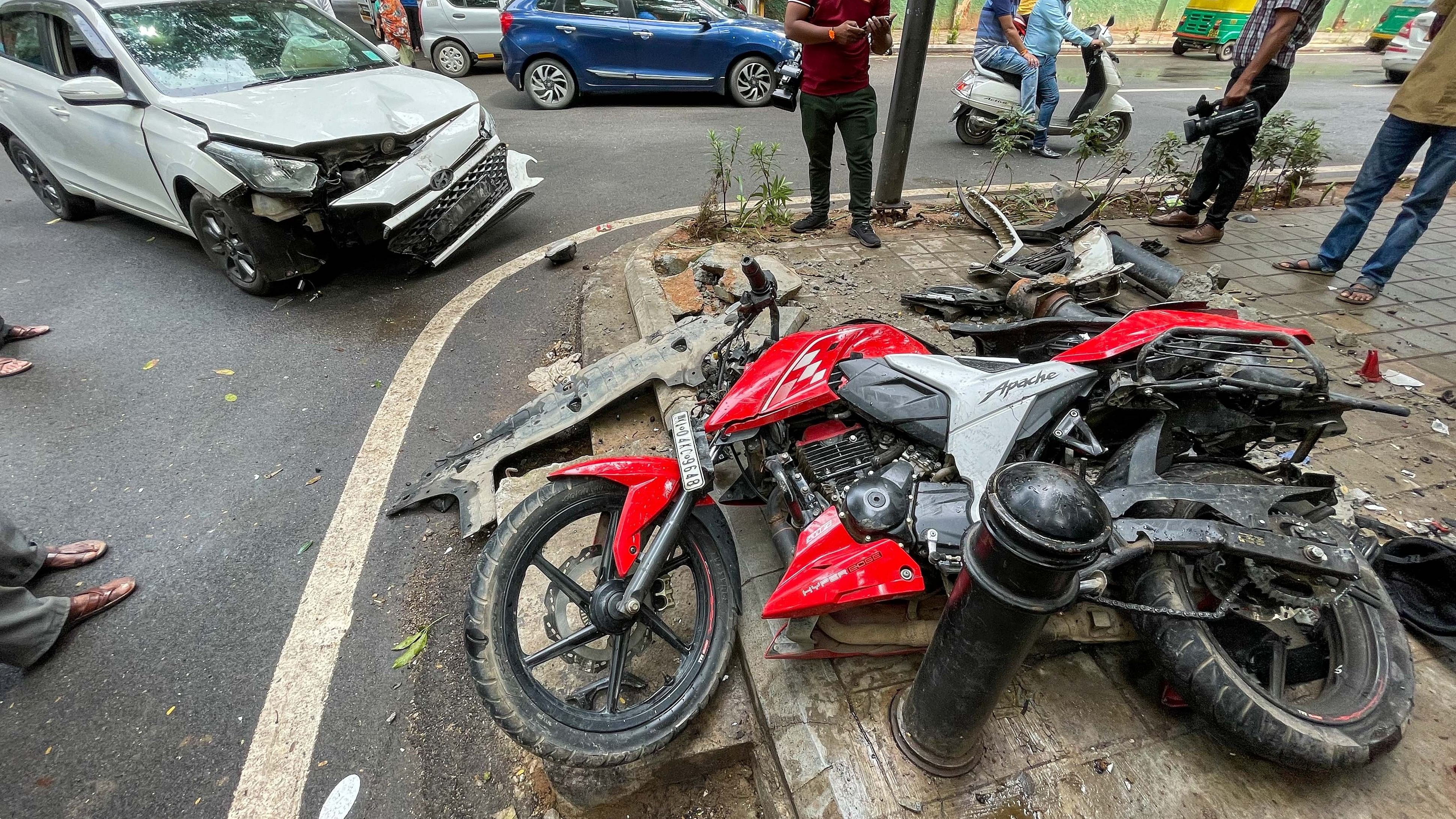
A speeding car collides with a motorbike on Ali Askar road, Bengaluru on Sunday knocking down the TenderSure boulders. Locals claim that the car belongs to a former BBMP corporator. All involved in the accident were been hospitalised.
Credit: DH Photo/Pushkar V
Bengaluru: The growing number of hit-and-run accidents over the years, coupled with a decrease in the number of cases successfully traced, has once again highlighted deficiencies in road infrastructure, road user behaviour, and the adequacy of current safety measures.
The Bengaluru Traffic Police’s recent report, ‘Road Traffic Accidents in Bengaluru City 2021-2023’, accessed by DH, indicates that the number of hit-and-run accidents surged by nearly 41% between 2021 and 2023. This increase coincides with a year-on-year rise in fatal accidents.
Since 2021, hit-and-run incidents have constituted 30%, or nearly one-third, of all fatal accidents annually. In 2023, 266 out of 883 fatal accidents fell into this category.
Dr. Gautham M S, Additional Professor of Epidemiology at the WHO Collaborating Centre for Injury Prevention and Safety Promotion, Nimhans, explained that these numbers can be attributed to several factors.
“A combination of shock, adrenaline, fear of public reaction and police action, and financial loss for the treatment of the person and vehicle are some of the factors that can cause individuals to flee the scene,” he stated.
Furthermore, driving under the influence significantly contributes to hit-and-run cases due to impaired decision-making, prompting individuals to flee, especially when faced with severe criminal charges.
However, if no serious injury has occurred, there is a 90% chance that people will stop to help the victim, he noted.
More concerning, perhaps, is the increase in the proportion of hit-and-run cases that remain untraced. In 2021, only 31 cases went untraced, a number that rose to 77 in 2023. Consequently, the traceability rate dropped from 83% in 2021 to 71% in the last year.
M N Anucheth, Joint Commissioner of Police (Traffic), said that this could be because some incidents occurring in one calendar year are only detected a few months into the following year, and thus are not reflected when the report is compiled every January.
“The detection rate, including the cases from the previous years, would thus increase over time,” he said.
Credit: DH Photo/Pushkar V
In 2023, the majority of these incidents occurred between 6 pm and midnight (96 cases), and approximately 40 cases occurred between midnight and 6 am.
To trace the accused in these cases, police rely on a combination of CCTV footage, informants, and forensic clues. However, incidents that take place late at night and in areas with poor visibility and insufficient CCTV coverage present significant detection challenges and often remain untraced.
Even so, scene of crime officers can at least determine the types of vehicles involved in these incidents, the majority of which are four-wheelers, according to Anucheth.
Data indicates that 229 out of 266 fatal hit-and-run cases in 2023 occurred on the main and sub-roads of the city, excluding the Central Business District (CBD) and the High-Density Corridors (HDC). This detail assists the traffic police in identifying dangerous areas and developing road safety mechanisms tailored to each road type, where speed may not be the sole factor contributing to accidents.
“Roads in the CBD have an average speed of 18 kmph, so speed doesn’t significantly contribute to accidents there. Then we examine the primary causes of accidents, which could be related to road engineering, vehicle volume, or other factors that may not apply elsewhere,” he explained.
For instance, NICE Road features several steep turns and undulations without proper banking at certain points, which can lead to accidents.
Urban mobility expert Ashwin Mahesh pointed out that most of the victims in such cases were pedestrians, which was so because the priorities of the city’s road infrastructure were misplaced.
“Unlike many other nations, we make roads for cars. Instead, footpaths should be made a priority on all roads. The lack of footpaths pushes pedestrians onto the streets, making them more vulnerable,” he said, noting that broken, non-uniform footpaths, including many that are merely drain covers serving as footpaths, and footpaths blocked by parked vehicles push people onto the roads, upping risks of road injury.
He also explained that many cases also go untraced because vehicles would have changed hands multiple times and are not registered appropriately.
“Police officials often get away by giving abstract reasons for their failures such as ‘the road was not lit’. Instead, officials concerned should be named and held responsible.”